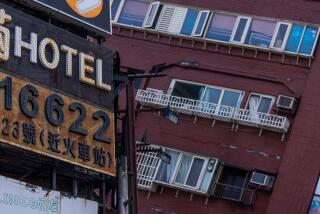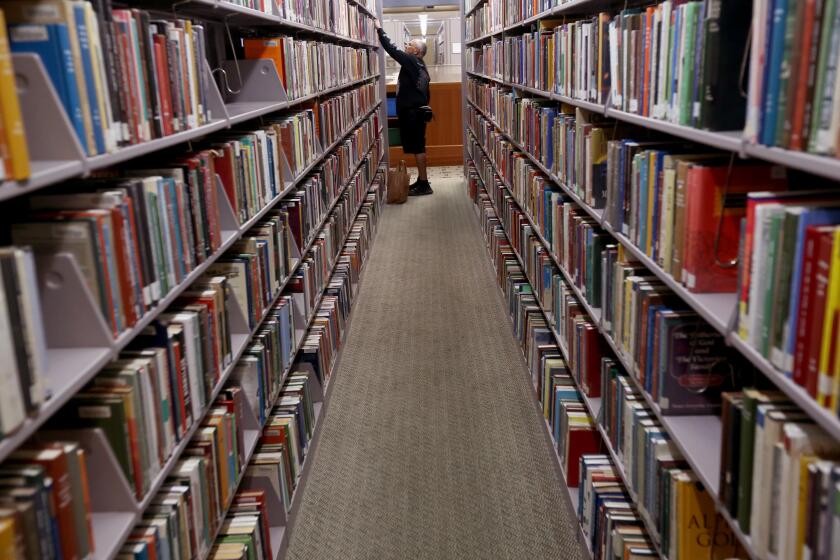Taiwan Hunts for Radioactive Apartments
- Share via
TAIPEI, Taiwan — One of the worst selling points for an apartment in Taiwan is to say it was built between 1982 and 1984.
Apartments constructed during that period are now the target of a great Taiwanese hunt for radioactive buildings.
“Between 1% and 2% of the 25,000 to 30,000 apartments checked until now are radioactive,” said Wang Mann-tchao, a vice-chairman of the Cabinet’s Atomic Energy Council (AEC).
The AEC began the search in August, 1992, and says it eventually wants to check 200,000 households island-wide.
Officials said the radioactivity comes from steel rods, and in some of the buildings it was high enough to pose a possible health risk--and to knock as much as 10% off the price of an apartment.
No one has been reported ill yet and Wang describes it as “really a psychological problem. They always think of this as equivalent to a nuclear bomb, but it’s not true.”
Fu Ben-jun doesn’t believe him. The 35-year-old Taipei businesswoman says she is not sure about the results of the test in April on her rented suburban apartment, but she is nevertheless moving out.
“You never know,” she said. “They give you all this technical jargon, I wouldn’t be able to understand it.
“I wanted to move but that speeded up my decision.”
The mystery started when steel bars being taken into a nuclear power plant set off alarm bells at the gate, Wang said.
“They then traced back through the manufacturer and found another building in Tienmu (a Taipei suburb) was contaminated,” he said.
The source of the radioactive steel has not been determined. Wang believes it was in imported scrap metal from the West, because the type of radioactivity comes from cobalt 60, which Taiwan does not produce.
The AEC decided to check every apartment built in Taiwan within a two-year period of when the steel was produced. Devices have been installed at steel plants to monitor incoming scrap metal.
“We estimated the radiation if they stay in an apartment 365 days a year and 24 hours a day,” Wang said. “We decided (if the occupant received) 1.5 rems in this time we’re going to buy the apartment.”
Rem stands for a unit of radiation that, when absorbed by a person, produces a certain physiological effect.
Some people whose apartments are going to be bought are haggling over the price with the government while prices for some apartments built in the 1982-84 periods have dropped.
“The selling price has certainly gone down,” Fu said of apartments in her complex.
She said prices have already dropped 10% from prices before the building was tested.
Officials did not know how widespread the problem is because of lax inspection practices and a lack of knowledge of the dangers of excessive radiation.
Two AEC officials were impeached last year for not reporting radiation at a dental office in 1985.
“They found that even before they turned the X-ray machine on, the Geiger counter went off,” Wang said.
He said that instead of reporting the problem, the inspectors only asked that a sheet of lead be placed over the wall where the radioactivity was coming from.
The first building discovered to be contaminated in the Taipei suburb was torn down because it was still under construction. The steel was buried.
But Wang said more than 10 metric tons of the steel has been stolen and he thinks it was used as a foundation for a factory.
“Regular (safety) procedures were not followed,” he said.
Apartments the government buys will be turned into storage spaces or reconstructed using lead protective sheets.
Wang, 47, a specialist in radiation with a doctorate from the University of Alabama, said that, excluding salaries, the AEC has spent about $15 million on the searches.
On top of this, he said, there is an unlimited budget to buy those apartments found to be heavily contaminated. He said the Cabinet will issue more compensation guidelines soon.
More to Read
Sign up for Essential California
The most important California stories and recommendations in your inbox every morning.
You may occasionally receive promotional content from the Los Angeles Times.










